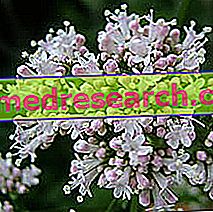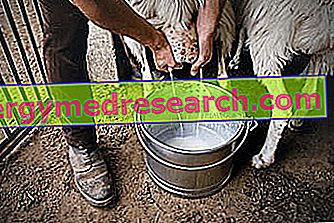
Scientific name
Valeriana officinalis
Family
Valerianaceae
Origin
Europe
Used Parts
Drug consisting of the roots and rhizomes of the plant (Official Pharmacopoeia)
Chemical constituents
- Essential oil (antispasmodic effect);
- Valepotriati (sedative effect) (valtrato, baldrinale);
- Valerianic acid;
- Isovaleranic acid;
- Valerenic acids;
- Malic acid;
- carbohydrates;
- Tannins;
- Flavonoids;
- Resins;
- Alkaloids (valeranine, actinidine and valtrossal).
Valeriana in Herbalist: Property of Valeriana
Valerian is a plant used primarily for its tranquilizing activity . In fact, in standardized extract, valerian is used in the treatment of insomnia and sleep disorders, but also in the complementary therapy of some anxiety-type manifestations (panic attacks, anxiety crisis, tremors, abdominal cramps, irritability, nervous tension, psychogenic vertigo, irritable colon, palpitations, headache).
Biological activity
To the valerian sedative properties of the central nervous system (or CNS), antispasmodics and anxiolytics are attributed.
More precisely, the sedative and anxiolytic activities seem to be exercised by the valepotriati and by some constituents of the essential oil of valerian, such as valerenic acid and valerenal. While the spasmolytic activities seem to be attributable to the only valerenic acid.
The mechanism by which these molecules are able to reduce the anxious component has to do with the metabolism of GABA (γ-aminobutyric acid), the main inhibitory neurotransmitter of the CNS. More in detail, it seems that these compounds contained within the valerian are capable of interfering with the degradation of GABA. Studies conducted on animals have also shown that, following the intake of valerian, there is an increase in GABA levels in the synaptic space, obtained by inhibiting reuptake and increasing the secretion of the same neurotransmitter.
The sedative and anxiolytic properties of valerian have been confirmed by several studies and it is for this reason that the use of the plant has been officially approved for the treatment of the states of agitation and the sleep disorders associated with them.
Valerian against agitation and sleep disorders
As stated above, the use of valerian is a valid aid in combating the agitation, restlessness and sleep disturbances that accompany them, thanks to the effects that the valepotriati, valerenic acid and valerenal exert on the central nervous system.
There are numerous valerian-based preparations commercially available for the treatment of the aforementioned disorders. Therefore, as regards the dosage of the product to be used, it is always advisable to follow the instructions on the leaflet, on the packaging or on the label of the product you intend to use.
In any case, approximately, for the treatment of agitation it is recommended to take about 200 mg of extract of valerian roots 2-3 times a day.
Against sleep disorders, on the other hand, the dose of extract usually recommended is 400-900 mg, to be taken at least thirty minutes before bedtime.
It should be noted that the doses reported above are purely indicative and refer to an extract obtained by mixing two parts of powdered valerian root with nine parts of water and six parts of alcohol.
Popular medicine
The virtues of valerian have been known to folk medicine since ancient times; times in which it was already used in the medical field. Even today, valerian is exploited in this area for the treatment of various disorders. These include headaches, difficulty concentrating, anxiety, hysteria, neurasthenia, neuralgia; moreover, the plant is even used as a remedy for epilepsy, but that's not all. Valerian, in fact, is also used to counter nerve colic, spasms of the smooth muscles of the uterus and the agitation associated with the menstrual cycle.
Valerian is also used in the homeopathic field, with indications for the treatment of insomnia, gastrointestinal spasms, agitation and restlessness.
Side effects
Cases of hepatotoxicity have been reported following valerian intake, although causality has yet to be established with certainty.
Furthermore, on rare occasions, valerian may cause side effects on the gastrointestinal tract.
In the case of prolonged use, on the other hand, side effects such as headache, agitation and sleep disorders may sometimes occur.
Contraindications
The use of valerian is contraindicated in the following cases:
- Ascertained hypersensitivity to one or more components;
- In patients with liver disease;
- In pregnancy and during breastfeeding without the prior advice of the doctor;
- In children and adolescents under 14 years of age.
Valerian: drug interactions
Taking valerian may interfere with the activity of substances or drugs, such as:
- Barbiturates, benzodiazepines and opioid analgesics, since the concomitant administration of the plant in question can cause excessive depression of the central nervous system.
- Loperamide, since the simultaneous use of valerian may favor the onset of delirium episodes characterized by agitation and disorientation.
- Medicinal plants and hepatotoxic drugs, because an increased risk of toxicity to the liver may occur.
- Antihistamines .
- Antidepressants .
- Alcohol, the plant can increase its sedative effects.
- Iron, since the concomitant intake of valerian can interfere with the absorption of iron itself.
Contraindications
Avoid using valerian in case of proven hypersensitivity to one or more components.
Pharmacological Interactions
- increases sleep time from barbiturates;
- interaction with benzodiazepines, antihistamines and alcohol.
Warnings
Exclusive use of standardized extracts in valerenic acids.



